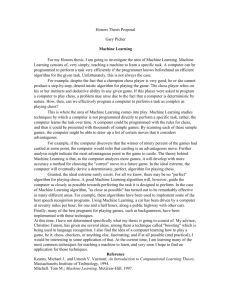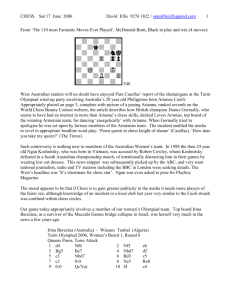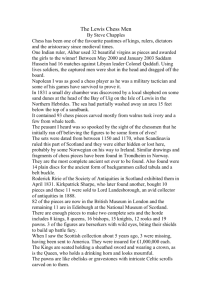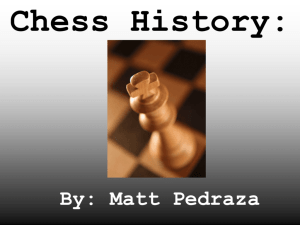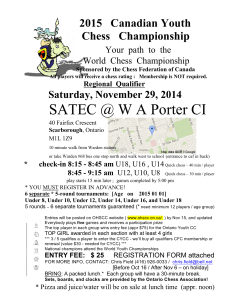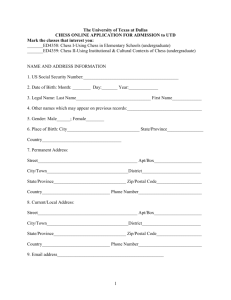ppt
advertisement
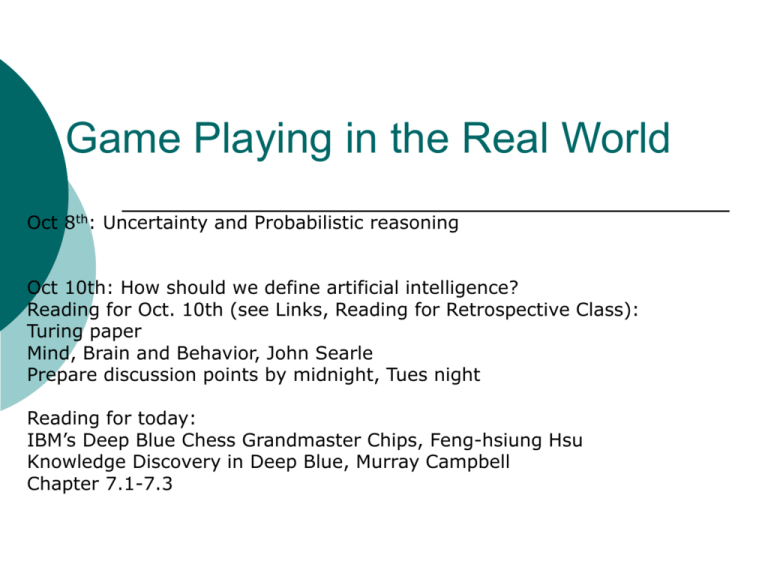
Game Playing in the Real World Oct 8th: Uncertainty and Probabilistic reasoning Oct 10th: How should we define artificial intelligence? Reading for Oct. 10th (see Links, Reading for Retrospective Class): Turing paper Mind, Brain and Behavior, John Searle Prepare discussion points by midnight, Tues night Reading for today: IBM’s Deep Blue Chess Grandmaster Chips, Feng-hsiung Hsu Knowledge Discovery in Deep Blue, Murray Campbell Chapter 7.1-7.3 Alpha-Beta Pruning 2 3 The α-β algorithm 4 What matters? Speed? Knowledge? Intelligence? (And what counts as intelligence?) Human vs. machine characteristics 5 The decisive game of the match was Game 2, which left a scare in my memory … we saw something that went well beyond our wildest expectations of how well a computer would be able to foresee the long-term positional consequences of its decisions. The machine refused to move to a position that had a decisive short-term advantage – showing a very human sense of danger. I think this moment could mark a revolution in computer science that could earn IBM and the Deep Blue team a Nobel Prize. Even today, weeks later, no other chess-playing program in the world has been able to evaluate correctly the consequences of Deep Blue’s position. (Kasparov, 1997) 6 Quotes from IEEE article Why, then, do the very best grandmasters still hold their own against the silicon beasts? The side with the extra half-move won 3 games out of four, corresponding to a 200-point gap in chess rating – roughly the difference between a typically grandmaster (about 2600) and Kasparov (2830) An opening innovation on move nine gave Kasparov not merely the superior game but one that Fritz could not understand Kasparov made sure that Fritz would never see the light at the end of that tunnel by making the tunnel longer. 7 8 Deep Blue – A Case Study Goals Win a match against human World Chess Champion Under regulation time control No faster than 3 min/move 9 Background Early programs emphasized emulation of human chess thought process 1970-1980: emphasis on hardware speed 1986-1996 Chess 4.5 Belle (1st national master program, early 80s) mid-1980s: Cray Blitz, Hitech Deep Thought, Deep Thought II 1988: 2nd Fredkin Intermediate Prize for Grandmaster level performance 1996: Deep Blue New chess chip, designed over a 3 year period 10 Problems to Overcome Gaps in chess knowledge Adaptation Speed Design Philosophy Integrate the maximally possible amount of software-modifiable chess knowledge on the chess chip 11 Deep Blue System Architecture Chess chip IBM RS/6000 SP supercomputer Searched 2-2.5 million chess positions/second Collection of 30 workstations (RS 6000 processors) Each processor controlled up to 16 chess chips 480 chess chips total Maximum speed: 1 billion chess positions/second Sustained speed: 200 million chess positions/second 12 Search Software/hardware mix: 1st 4 plies: 1 workstation node 2nd 4 plies: in parallel over 30 workstations nodes Remaining plies: in hardware 13 14 15 Evaluation Functions An ideal evaluation function would rank terminal states in the same way as the true utility function; but must be fast Typical to define features, & make the function a linear weighted sum of the features 16 Weighted Linear Function Eval(s)=w1F1(s)+w2F2(s)+…+wnFn(s) Given features and weights Assumes independence Can use expert knowledge to construct an evaluation function Can also use self-play and machine learning 17 Evaluation functions in Deep Blue Opening moves Evaluation during a game 8000 feature evaluation E.g., square control, pins, x-rays, king safety, pawn structure, passed pawns, ray control, outposts, pawn majorigy, rook on the 7th blockade, restraint, color complex, trapped pieces,….. Weighted non-linear function End games Large endgame databases of solved positions, with 5 or 6 pieces. 18 Using expert decisions Database of 4000 opening moves Extended book 700,000 Grandmaster games For each of the first 30 or so moves, compute an evaluation for each move that has been played Scores are used as evaluation fns to bias the search 19 A Sample of Evaluation features The number of times a move has been played Relative number of times a move has been played Strength of the players that played the moves Recentness of the move Results of the move Commentary on the move Game moves vs. commentary moves 20 21 Impact Program with quiescence search matches a program without quiescence search but searching 4 plies deeper QS increases #positions searched 2-4 times 4 more plies of search is up to a thousand times increase 22 Quiescence Search in Deep Blue 1997 match Software search extended to about 40 plies along forcing lines Nonextended search researched about 12 plies 23 Quotes from IEEE article Why, then, do the very best grandmasters still hold their own against the silicon beasts? The side with the extra half-move won 3 games out of four, corresponding to a 200-point gap in chess rating – roughly the difference between a typically grandmaster (about 2600) and Kasparov (2830) An opening innovation on move nine gave Kasparov not merely the superior game but one that Fritz could not understand Kasparov made sure that Fritz would never see the light at the end of that tunnel by making the tunnel longer. 24 Discussion How intelligent are chess playing programs? How like humans are programs? How to explain the 1997 match vs the 2002 match with Fritz? Is chess playing a solved problem? What would be some next directions? 25

